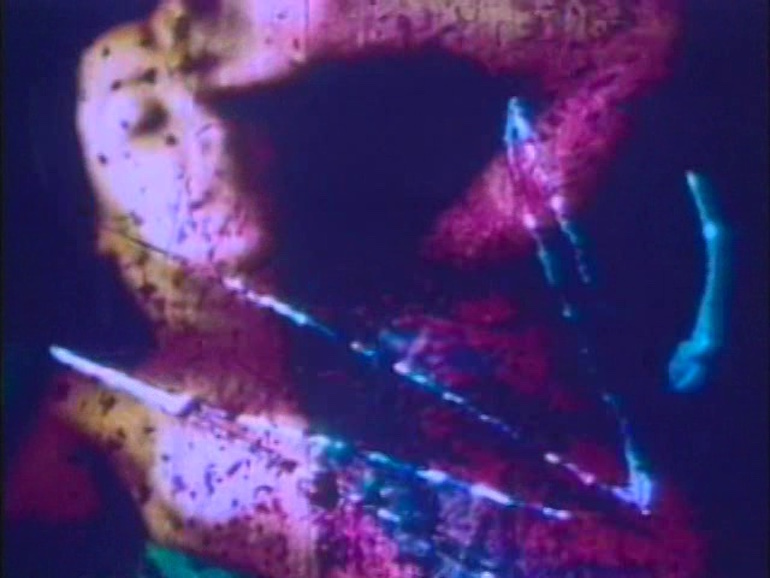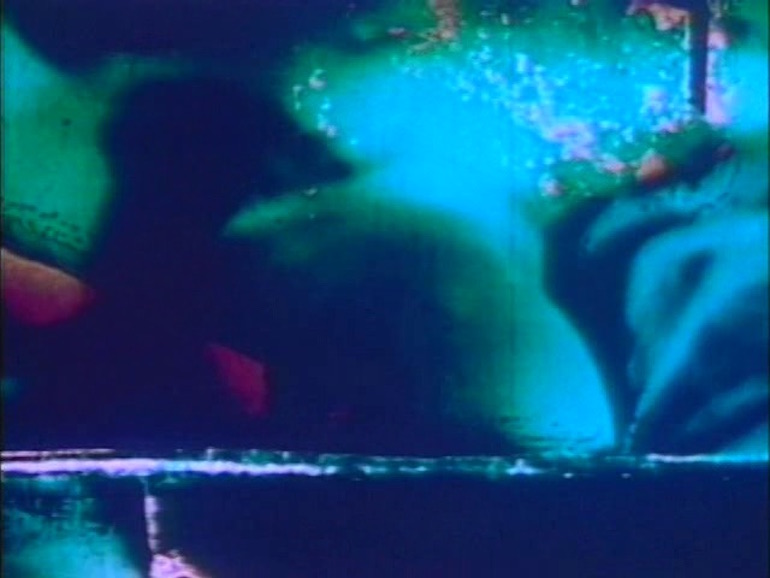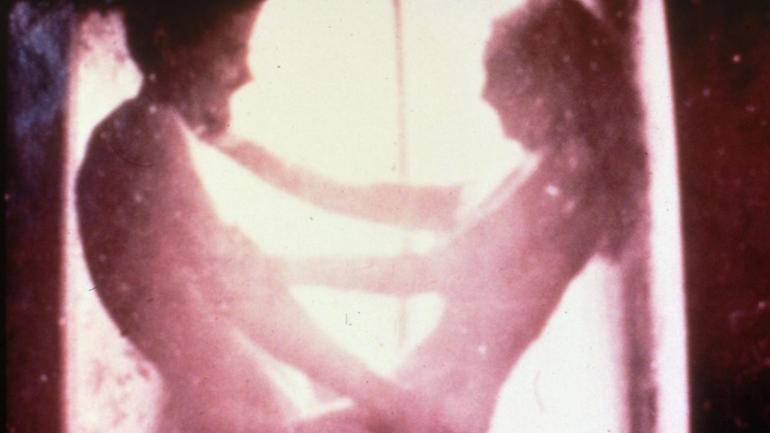ABOUT FUSES
Interview to Carolee Schneemann by Scott MacDonald
 FORWARD
FORWARD
 DOWNLOAD
DOWNLOAD

Scott MacDonald: Have audiences for Fuses changed much over the years?
Schneemann: Oh, yes. There was that revelatory time when Fuses was first shown around 1967-68, when not a lot but a certain number of women and a very large number of men in the audience felt that it was giving them hack a sort of wholeness. They said it was very positive for them, and women would say that they had never looked at their genitals and had never felt accepting of them and this was a chance to make the kind of integration and ‘fusion’ about self they really wanted. There's a thread of that that keeps going on. There is also tremendous resistance to it—silliness and pain that's masked as a kind of hostility or tacky aggressiveness. One of the most extreme things happened when I was in the audience at Cannes. About forty men went berserk and tore up all the seats in the theater, slashed them with razors, shredded them, and threw all the padding around. It was terrifying, and peculiar.
MacDonald: They came prepared?
Schneemann: I don't know; the theater was full. Fuses was on the program of special jury selections, most of which were socially political (it was 1968) compared to Fuses, which was sexually political. The people who went crazy were French, youngish; they looked sort of middle class in their dress. I don't know what they were screaming or why. I was very bewildered. I thought at the time that it had to do with the lack of predictable pornographic narrative sequence. There was also a fight at the University of Massachusetts in 1973, where some man in the audience said he didn't get a hard-on, so what's the point to it? And a woman in the back row said to him something like, ‘You didn't get a hard-on because you wouldn't recognize something that was truly sexual if it sat on your lap.’ And he turned around and said, ‘Who the fuck do you think you are? You're just another one of those dumb bitches who…’, something or other; I don't remember exactly. Anyway, she called him a stupid prick—this is in the university auditorium!- and the professors were banging on the tables, and the students were yelling, and somebody took a newspaper and hit the man on the head with it. Finally they remembered me and shouted, ‘What do you think about the audience fighting?’ And I said, ‘It seems to be very cathartic for you; it's better than struggling over dull questions.’
In 1972 or 1973 at the Art Institute in Chicago there was a group of lesbian separatists who were extremely angry about the film. They said, ‘There's no role model for us in here, and we don't want to have to look at it.’ Well, of course, I felt that, first, they didn't have to look at it, and, second, they were perfectly justified to object to it, because if they needed a role model, the heterosexual one in Fuses was going to be antagonistic. But then a woman yelled to them, ‘All my life I've been pushed around by fascistic men telling me what to look at and what it means, and I'm not going to be pushed around by fascistic women telling me what to look at and what it means.’ Big applause from another contingent. And then still another woman put her head up and said, ‘The role model in the film is the fact that the filmmaker envisions her own life, and we should see it in that way.’ More fighting and arguing.
About three years ago, in California, Fuses was seen as ‘sentimental shit.’ You don't usually hear much about what people really say or think about your work. Other things invitations, phone calls, who remembers your name, stuff like that are telling you what kind of rating you've got in the art world. Anyway, there was this time in California where, I'm told, people really hated it and booed and walked out. I try to make all my things to go on their own for a long duration; it's up to them to absorb the shocks.

MacDonald: The amount of negative reaction seems strange to me. Just in terms of colors and textures Fuses is so beautiful to look at.
Schneemann: Well, it used to be considered too ugly to look at: jumbled, broken, chaotic. In California it seems to have become too beautiful. Perhaps the California people were into leather and, straps. A lot of things have been considered indulgent in the past couple of years. Heterosexual love has been a luxury that some women cannot psychologically afford. It's too fraught with compromise and diversion of energies that have to be women-identified among and with other women.
MacDonald: It seems very apparent when I watch Fuses that though you and Jim Tenney had known each other for a long time, you were still pretty fascinated with each other. At least on one level, all the different lighting conditions in the film, the different tones, all the different technical things that go on suggest your long-term erotic exploration of each other.
Schneemann: Also there is a prolonged time duration in it. It doesn't have the titillating quality of dramatic immediacy.
MacDonald: It suggests that you can sustain that level of passion over a long period of time.
Schneemann: Hopefully, yes. That's a normal expectation of mine. Fuses is, in part, an answer to Brakhage's Loving, which Jim and I are in. Brakhage made Loving because of his fascination with the erotic sensitivity and vitality that was between Jim and me. That was something very important for him to be seeing and caring about. But I felt that Loving failed to capture our central eroticism, and I wanted to set that right. Actually, I hate what happens when I'm in somebody else's work, with the exception of a Bill Brand film, Split Decision, which is all invention anyway. I always feel a tremendous distortion has been enacted on me, despite my hope that some coherent self will come through.

Another thing I was thinking about at the time is the issue of equity be-tween couples. There's a tremendous resistance to that; there's always got to be one person on top, right? I always thought it was a particular value that a couple could have this equity between them, and Jim took a lot of flack for that. Men, in particular, thought he wasn't getting the advantages he should. They didn't mean about the sex, but in our daily life. People would be around and see that he was going to do the dishes while I cooked, or that they couldn't come over at a certain time because that's when I was working in my little part of the house and couldn't be disturbed. There was a tremendous amount of hostility towards me, as if he was being victimized by something if I wasn't going to serve him. But it had a double edge; it had an erotic fascination because it was also very sexy. People were always saying, ‘You can't live like this.’
Also, they presumed that influences only went one way. Jim influenced me; I could never in twelve years be an influence on him. Almost no one thought we could both be good for each other. That kind of thing is still going on. I used to watch it with other people. When John and Yoko were first together, the general response, other than that of the fascinated fans, was vicious. All the artists would say, ‘Lennon is ruining her quixotic imagination,’ and all the pop people would say, ‘He's with that freaky avant-garde woman, and she's ruining his mind.’ Never the celebration of the two of them bringing to each other what they did.
Extracts of the interview by Scott MacDonald to Carolee Schneemann in: Scott MacDonald (1988). A Critical Cinema. Interviews with Independent Filmmakers. University of California Press. Berkeley.
Nº 8 PORTRAIT AS AN ACTRESS, SELF-PORTRAIT AS A FILMMAKER
Editorial. Portrait as an actress, self-portrait as a filmmaker
Gonzalo de Lucas
DOCUMENTS
About the femenine
Maya Deren
About Fuses
Carolee Schneemann
Conversation about Wanda by Barbara Loden
Marguerite Duras and Elia Kazan
About the Film-Diary
Anne-Charlotte Robertson
Nothing to say
Chantal Akerman
FILMS UNDER DISCUSSION. INTERVIEWS
About the Women Film Pioneers Project
Alejandra Rosenberg
Medeas. Interview with María Ruido
Palma Lombardo
VIDEO ESSAY
Florencia Aliberti, Caterina Cuadros and Gala Hernández
ARTICLES
Lois Weber: the female thinking in movementWeber: the female thinking in movement
Núria Bou
‘One must at least begin with the body feeling’: Dance as filmmaking in Maya Deren’s choreocinema
Elinor Cleghorn
Nothing of the Sort: Barbara Loden’s Wanda (1970)
Cristina Álvarez López and Adrian Martin
The Trouble with Lupino
Amelie Hastie
Presence (appearance and disappearance) of two Belgian filmmakers
Imma Merino
Identity self-portraits of a filmic gaze. From absence to (multi)presence: Duras,Akerman, Varda
Lourdes Monterrubio Ibáñez
REVIEW
Jorge Oter; Santos Zunzunegui (Eds.) José Julián Bakedano: Sin pausa / Jose Julian Bakedano: Etenik gabe
María Soliña Barreiro

